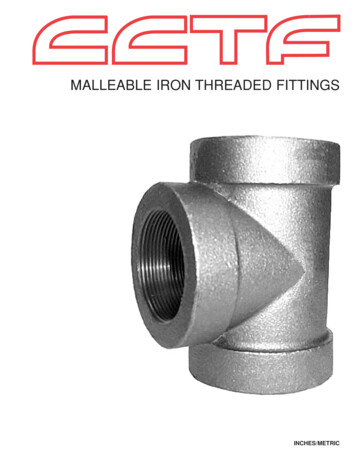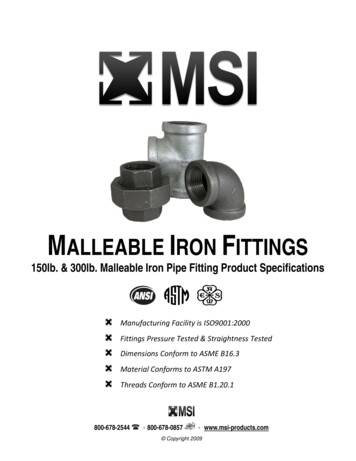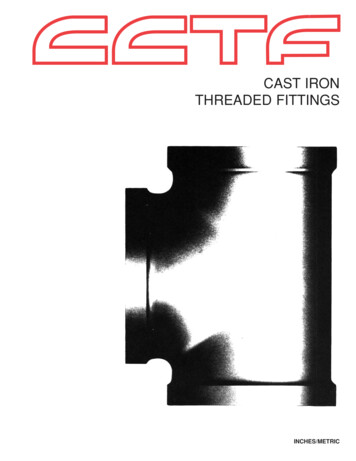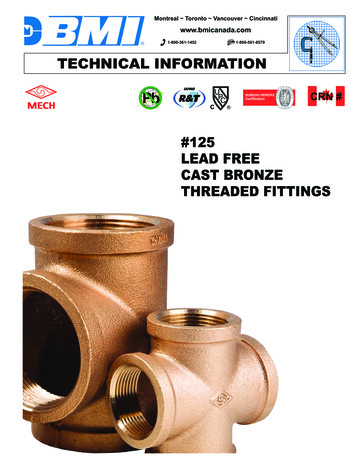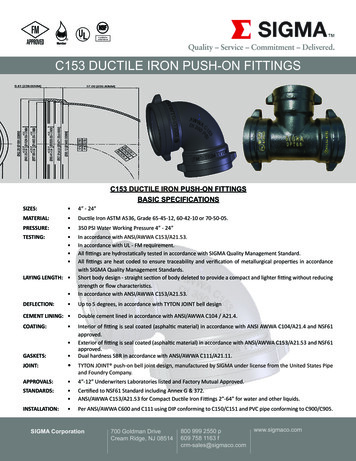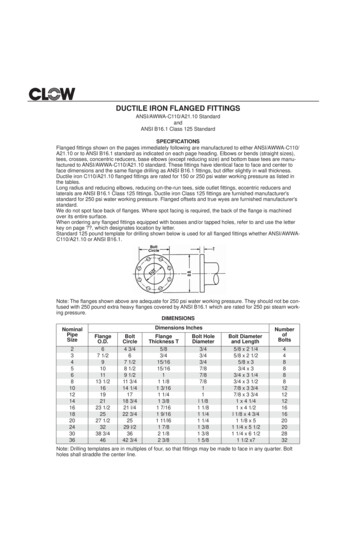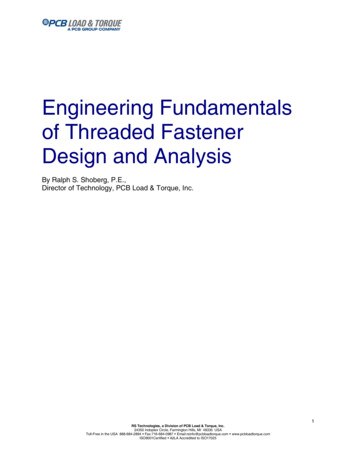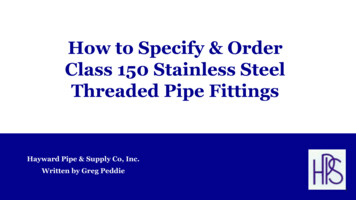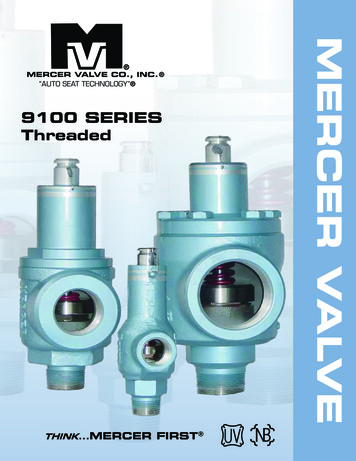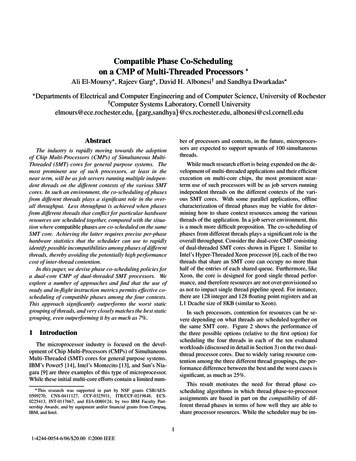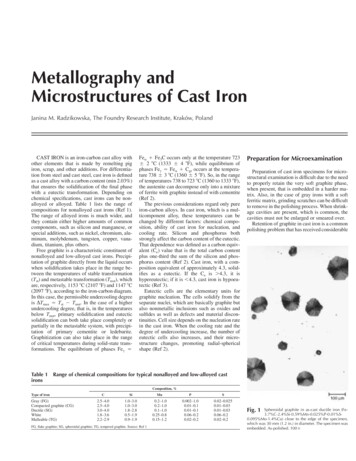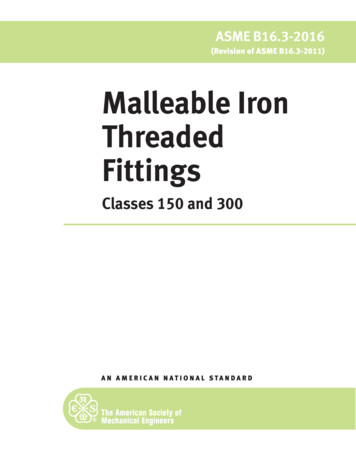
Transcription
ASME B16.3-2016(Revision of ASME B16.3-2011)Malleable IronThreadedFittingsClasses 150 and 300A N A M E R I C A N N AT I O N A L STA N DA R D
ASME B16.3-2016(Revision of ASME B16.3-2011)Malleable IronThreadedFittingsClasses 150 and 300A N A M E R I C A N N AT I O N A L S TA N D A R DTwo Park Avenue New York, NY 10016 USA
Date of Issuance: November 30, 2016The next edition of this Standard is scheduled for publication in 2021.ASME issues written replies to inquiries concerning interpretations of technical aspects of thisStandard. Periodically certain actions of the ASME B16 Committee may be published as Cases. Casesand interpretations are published on the ASME Web site under the Committee Pages athttp://cstools.asme.org/ as they are issued.Errata to codes and standards may be posted on the ASME Web site under the Committee Pages toprovide corrections to incorrectly published items, or to correct typographical or grammatical errorsin codes and standards. Such errata shall be used on the date posted.The Committee Pages can be found at http://cstools.asme.org/. There is an option available toautomatically receive an e-mail notification when errata are posted to a particular code or standard.This option can be found on the appropriate Committee Page after selecting “Errata” in the “PublicationInformation” section.ASME is the registered trademark of The American Society of Mechanical Engineers.This code or standard was developed under procedures accredited as meeting the criteria for American NationalStandards. The Standards Committee that approved the code or standard was balanced to assure that individuals fromcompetent and concerned interests have had an opportunity to participate. The proposed code or standard was madeavailable for public review and comment that provides an opportunity for additional public input from industry, academia,regulatory agencies, and the public-at-large.ASME does not “approve,” “rate,” or “endorse” any item, construction, proprietary device, or activity.ASME does not take any position with respect to the validity of any patent rights asserted in connection with anyitems mentioned in this document, and does not undertake to insure anyone utilizing a standard against liability forinfringement of any applicable letters patent, nor assumes any such liability. Users of a code or standard are expresslyadvised that determination of the validity of any such patent rights, and the risk of infringement of such rights, isentirely their own responsibility.Participation by federal agency representative(s) or person(s) affiliated with industry is not to be interpreted asgovernment or industry endorsement of this code or standard.ASME accepts responsibility for only those interpretations of this document issued in accordance with the establishedASME procedures and policies, which precludes the issuance of interpretations by individuals.No part of this document may be reproduced in any form,in an electronic retrieval system or otherwise,without the prior written permission of the publisher.The American Society of Mechanical EngineersTwo Park Avenue, New York, NY 10016-5990Copyright 2016 byTHE AMERICAN SOCIETY OF MECHANICAL ENGINEERSAll rights reservedPrinted in U.S.A.
CONTENTSForeword . . . . . . . . . . . . . . . . . . . . . . . . . . . . . . . . . . . . . . . . . . . . . . . . . . . . . . . . . . . . . . . . . . . . . . . . . . . . . .Committee Roster . . . . . . . . . . . . . . . . . . . . . . . . . . . . . . . . . . . . . . . . . . . . . . . . . . . . . . . . . . . . . . . . . . . . .Correspondence With the B16 Committee . . . . . . . . . . . . . . . . . . . . . . . . . . . . . . . . . . . . . . . . . . . . . .Summary of Changes . . . . . . . . . . . . . . . . . . . . . . . . . . . . . . . . . . . . . . . . . . . . . . . . . . . . . . . . . . . . . . . . . .List of Changes in Record Number Order . . . . . . . . . . . . . . . . . . . . . . . . . . . . . . . . . . . . . . . . . . . . . .ivviviiixx1Scope . . . . . . . . . . . . . . . . . . . . . . . . . . . . . . . . . . . . . . . . . . . . . . . . . . . . . . . . . . . . . . . . . . . . . . . . . . . . .12General . . . . . . . . . . . . . . . . . . . . . . . . . . . . . . . . . . . . . . . . . . . . . . . . . . . . . . . . . . . . . . . . . . . . . . . . . . .13Pressure–Temperature Ratings . . . . . . . . . . . . . . . . . . . . . . . . . . . . . . . . . . . . . . . . . . . . . . . . . . . . . .14Size. . . . . . . . . . . . . . . . . . . . . . . . . . . . . . . . . . . . . . . . . . . . . . . . . . . . . . . . . . . . . . . . . . . . . . . . . . . . . . .25Marking . . . . . . . . . . . . . . . . . . . . . . . . . . . . . . . . . . . . . . . . . . . . . . . . . . . . . . . . . . . . . . . . . . . . . . . . . . .26Material . . . . . . . . . . . . . . . . . . . . . . . . . . . . . . . . . . . . . . . . . . . . . . . . . . . . . . . . . . . . . . . . . . . . . . . . . . .27Dimensions and Tolerances . . . . . . . . . . . . . . . . . . . . . . . . . . . . . . . . . . . . . . . . . . . . . . . . . . . . . . . . .28Threading . . . . . . . . . . . . . . . . . . . . . . . . . . . . . . . . . . . . . . . . . . . . . . . . . . . . . . . . . . . . . . . . . . . . . . . . .39Ribs . . . . . . . . . . . . . . . . . . . . . . . . . . . . . . . . . . . . . . . . . . . . . . . . . . . . . . . . . . . . . . . . . . . . . . . . . . . . . .310Plugs, Bushings, and Locknuts . . . . . . . . . . . . . . . . . . . . . . . . . . . . . . . . . . . . . . . . . . . . . . . . . . . . .411Face Bevel. . . . . . . . . . . . . . . . . . . . . . . . . . . . . . . . . . . . . . . . . . . . . . . . . . . . . . . . . . . . . . . . . . . . . . . . .412Coatings . . . . . . . . . . . . . . . . . . . . . . . . . . . . . . . . . . . . . . . . . . . . . . . . . . . . . . . . . . . . . . . . . . . . . . . . . .4Figures1 Identification of Reducing Fittings . . . . . . . . . . . . . . . . . . . . . . . . . . . . . . . . . . . . . . . . . . . . . . . .2 Gaging of Chamfered Internal Threads . . . . . . . . . . . . . . . . . . . . . . . . . . . . . . . . . . . . . . . . . . . .23Tables1 Pressure–Temperature Ratings . . . . . . . . . . . . . . . . . . . . . . . . . . . . . . . . . . . . . . . . . . . . . . . . . . . .2 Inspection Tolerances . . . . . . . . . . . . . . . . . . . . . . . . . . . . . . . . . . . . . . . . . . . . . . . . . . . . . . . . . . . . .3 Dimensions of Class 150 90-deg Elbows, Tees, and Crosses, and 45-deg Elbows(Straight Sizes) . . . . . . . . . . . . . . . . . . . . . . . . . . . . . . . . . . . . . . . . . . . . . . . . . . . . . . . . . . . . . . . . .4 Dimensions of Class 150 90-deg Elbows and Crosses (Reducing Sizes) . . . . . . . . . . . . . .5 Dimensions of Class 150 Tees (Reducing Sizes) . . . . . . . . . . . . . . . . . . . . . . . . . . . . . . . . . . . .6 Dimensions of Class 150 45-deg Y-Branches (Straight Sizes) . . . . . . . . . . . . . . . . . . . . . . . .7 Dimensions of Class 150 Street Tees and 90-deg and 45-deg Street Elbows . . . . . . . . . .8 Dimensions of Class 150 Couplings (Straight and Reducing Sizes) . . . . . . . . . . . . . . . . . .9 Dimensions of Class 150 Caps . . . . . . . . . . . . . . . . . . . . . . . . . . . . . . . . . . . . . . . . . . . . . . . . . . . .10 Dimensions of Class 150 Closed-, Medium-, and Open-Pattern Return Bends . . . . . . .11 Dimensions of Class 300 90-deg Elbows, Tees, and Crosses, and 45-deg Elbows(Straight Sizes) . . . . . . . . . . . . . . . . . . . . . . . . . . . . . . . . . . . . . . . . . . . . . . . . . . . . . . . . . . . . . . . . .12 Center-to-End Dimensions of Class 300 90-deg Elbows (Reducing Sizes) . . . . . . . . . . . .13 Center-to-End Dimensions of Class 300 Tees (Reducing Sizes) . . . . . . . . . . . . . . . . . . . . . .14 Dimensions of Class 300 Couplings . . . . . . . . . . . . . . . . . . . . . . . . . . . . . . . . . . . . . . . . . . . . . . .15 Dimensions of Class 300 Reducing Couplings . . . . . . . . . . . . . . . . . . . . . . . . . . . . . . . . . . . . .16 Dimensions of Class 300 Caps . . . . . . . . . . . . . . . . . . . . . . . . . . . . . . . . . . . . . . . . . . . . . . . . . . . .17 Dimensions of Class 300 90-deg and 45-deg Street Elbows . . . . . . . . . . . . . . . . . . . . . . . . .18 Dimensions of Class 300 Return Bends . . . . . . . . . . . . . . . . . . . . . . . . . . . . . . . . . . . . . . . . . . . .556789101112131414151617181919Mandatory AppendicesIDimensions of Fittings in U.S. Customary Units . . . . . . . . . . . . . . . . . . . . . . . . . . . . . . . . . . .IIReferences . . . . . . . . . . . . . . . . . . . . . . . . . . . . . . . . . . . . . . . . . . . . . . . . . . . . . . . . . . . . . . . . . . . . . . . .2138Nonmandatory AppendixAQuality System Program . . . . . . . . . . . . . . . . . . . . . . . . . . . . . . . . . . . . . . . . . . . . . . . . . . . . . . . . . .39iii
FOREWORDIn 1921, the American Engineering Standards Committee, later the American StandardsAssociation (ASA) and currently the American National Standards Institute (ANSI), authorizedthe organization of a Sectional Committee on the Standardization of Pipe Flanges and FlangedFittings, with the following organizations as joint sponsors: Heating, Piping, and Air ConditioningContractors National Association [later the Mechanical Contractors Association of America,(MCAA)], Manufacturers Standardization Society of the Valves and Fittings Industry (MSS), andThe American Society of Mechanical Engineers (ASME).Threaded fittings were also included in the scope of the B16 Committee, and SubcommitteeNumber 2 (now Subcommittee B) was made responsible for threaded fittings other than steel.The first edition of a standard covering 150-lb malleable iron fittings was approved as an AmericanTentative Standard by ASA in December 1927. In 1936, a revision was undertaken to add hydraulicservice ratings, material specifications, alignment tolerances, and dimensions for additional sizes.It was approved with the designation American Standard B16c-1939.Pipe plugs, bushings, and locknuts, included in the first editions, are now covered in a separatestandard, B16.14.A revision begun in 1947 amplified the sections on threading, inspection, and tolerances, andadded dimensions for additional sizes of elbows, reducing crosses, reducing tees, straight andreducing couplings, caps, and return bends. It was approved as ASA B16.3-1951.Meanwhile, MSS, in cooperation with the Association of American Railroads (AAR), developedthe first standard for 300-lb malleable iron threaded fittings, published as MSS SP-31 of 1932.The 1950 edition of SP-31, which agreed with AAR Purchase Specification M-404, was submittedto ASA Sectional Committee B16 and assigned to Subcommittee Number 2. After balloting, itwas approved as a separate standard, ASA B16.19-1951.Work was begun to combine the two standards (for 150 lb and 300 lb) into a single documentin 1961. The resulting standard was approved as ASA B16.3-1963. Subsequent reviews of thestandard, leading to revisions approved as ANSI B16.3-1971 and ANSI B16.3-1977, involvedupdating referenced standards and the introduction of metric (SI) dimensions and ratings. In the1977 edition, 150 lb and 300 lb were redesignated as Class 150 and Class 300, respectively.In 1982, American National Standards Committee B16 became the ASME B16 StandardsCommittee, operating with the same scope under ASME procedures accredited by ANSI. Afurther revision of the standard, approved and published as ANSI/ASME B16.3-1985, providedfor electrodeposition as an alternative to hot dipping when zinc coating was required.The 1992 edition of B16.3 omitted metric units, establishing U.S. Customary units as thestandard. Clarifications and editorial revisions were made to improve the text. Following approvalby the Standards Committee and ASME, the 1992 edition received approval as an AmericanNational Standard on December 2, 1992, with the designation ASME B16.3-1992.In the 1998 edition of ASME B16.3, the References section was updated; a Quality SystemProgram Annex was added; and several editorial revisions were made. Following approval byASME B16 Subcommittee B and B16 Main Committee, ANSI approved it as an American NationalStandard on November 20, 1998.In the 2006 edition, metric dimensions became the primary units and inch dimensions wereincorporated into this Standard as secondary units and shown in parentheses. The added metricdimensions constitute an independent but equal standard to the inch units. Following approvalby the Standards Committee and the ASME Board, this revision to the 1998 edition of thisStandard was approved as an American National Standard by ANSI on November 9, 2006 withthe new designation, ASME B16.3-2006.In the 2011 edition, references to ASME standards were revised to no longer list specificedition years; the latest edition of ASME publications applies unless stated otherwise. Materialsmanufactured to other editions of the referenced ASTM standards have been permitted to beused to manufacture fittings meeting the requirements of this Standard as long as the fittingiv
manufacturer verifies the material meets the requirements of the referenced edition. Followingapproval by the Standards Committee and the ASME Board on PTCS, the 2011 revision wasapproved as an American National Standard by ANSI on August 9, 2011 with the new designation,ASME B16.3-2011.In this 2016 Edition, provisions have been made to update verbiage and readings. Followingthe approval by the ASME B16 Standards Committee, approval as an American National Standardwas given by ANSI on September 26, 2016, with the new designation ASME B16.3-2016.v
ASME B16 COMMITTEEStandardization of Valves,Flanges, Fittings, and Gaskets(The following is the roster of the Committee at the time of approval of this Standard.)STANDARDS COMMITTEE OFFICERSR. Bojarczuk, ChairC. E. Davila, Vice ChairC. Ramcharran, SecretarySTANDARDS COMMITTEE PERSONNEL
ASME B16.3-2016 (Revision of ASME B16.3-2011) Malleable Iron Threaded Fittings Classes 150 and 300. ASME B16.3-2016 (Revision of ASME B16.3-2011) Malleable Iron Threaded Fittings Classes 150 and 300 AN AMERICAN NATIONAL STANDARD Two Park Avenue New York, NY 10016 USA. Date of Issuance: November 30, 2016 The next edition of this Standard is scheduled for publication in 2021.
